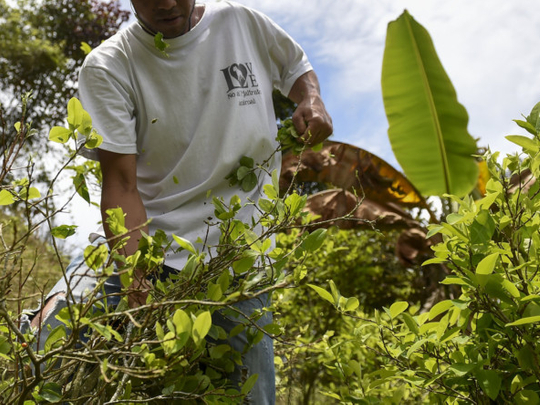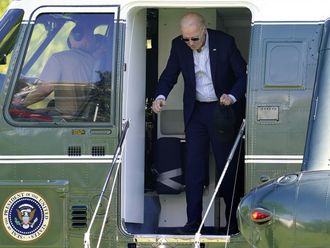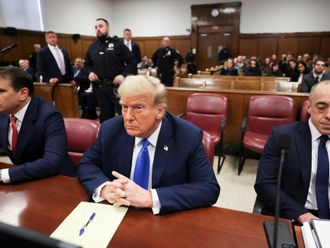
From a military helicopter high above the rolling hills of southern Colombia, the green rows of hearty plants look a bit like the vineyards of California’s Napa Valley. But that’s not zinfandel down there. Bushy fields of illegal coca blanket the countryside, ripe with the raw ingredients of the biggest cocaine boom in history.
Seventeen years and $10 billion after the US government launched the counternarcotics and security package known as Plan Colombia, America’s closest drug-war ally is covered with more than 460,000 acres of coca. Colombian farmers have never grown so much, not even when Pablo Escobar ruled the drug trade.
The peace accord signed last year by the Colombian government and leftist Farc rebels to end their 52-year war committed the guerrillas to quit the narcotics business and help rural families switch to legal crops. But the cash benefits available through the peace deal appear to have created a perverse incentive for farmers to stuff their fields with as many illegal plants as possible.
The result is a cocaine market so saturated that prices have crashed and unpicked coca leaves are rotting in the fields, according to Luis Carlos Villegas, Colombia’s defence minister. “We’ve never seen anything like it before,” said Villegas.
He and other top officials concede that the end of the war with the Farc, or Revolutionary Armed Forces of Colombia, has made the drug fight more difficult, not less. The days when US-funded aircraft could douse coca plantations with herbicide are over. A problem that could once be attacked with blunt military force has morphed into a sociological, state-building challenge.
“Frankly, we don’t believe violence is the right instrument to rid Colombia of coca,” said Villegas.
He and other Colombian officials have developed what is arguably the most comprehensive, well-researched anti-narcotics strategy ever attempted, offering cash incentives for entire communities to switch to alternative crops, while sending eradication crews to rip up the plants of those who refuse.
But the government says its strategy needs more time to succeed. US lawmakers are growing impatient. Colombia produced a whopping 710 metric tonnes of cocaine last year, according to US government estimates, up from 235 metric tonnes in 2013.
At a time when much of America’s drug fight has shifted to the opioid abuse crisis, US cocaine use is soaring. American officials say the flood of cheap Colombian product is so large that it’s quietly created its own demand.
US cocaine overdose deaths are at a 10-year high, and between 2013 and 2015, the number of young Americans who said they used cocaine for the first time increased 61 per cent, according to the latest report by the US Substance Abuse and Mental Health Services Administration.
“What is happening is the counter-argument to the suggestion that demand always drives supply,” said William Brownfield, the State Department’s top anti-narcotics official. “In this case, any rational observer would say the supply of the product right now is dramatically greater than the demand.”
The Farc funded its half-century insurgency partly on drug profits. It taxed coca growers and traffickers, or sold cocaine directly to the Mexican cartels that control access to the world’s biggest drug market, the United States.
But with the vast majority of the Farc’s 7,000 fighters ready to lay down their weapons, the guerrilla group has essentially gotten out of the drug trade, top US and Colombian officials say.
The Farc’s demobilisation has set off a deadly scramble for control of Colombia’s multibillion-dollar cocaine business, pitting trafficking gangs against one another and the country’s smaller communist rebel group, the ELN, or the National Liberation Army.
Under the terms of Colombia’s peace accord, the Farc has pledged to work with coca farmers in the remote communities long under its control, helping them plant alternative cash crops such as coffee, bananas and cacao. But it’s likely to be at least several months before ex-combatants are ready to join those programmes.
In the meantime, the Colombian government insists it is fighting the coca boom on all fronts. Colombian security agencies that work closely with the US Drug Enforcement Agency are seizing record amounts of cocaine — 115 metric tonnes through the first four months of 2017.
Getting farmers to stop growing so much coca may be a bigger challenge. Colombian officials have begun showing up in their communities with cash payments for farmers who voluntarily pull up their coca and enter a two-year programme to transition to legal crops.
Areas that faithfully comply will receive technical and commercial support, and funding for public works like roads, clinics and athletic fields. The catch? The entire community has to be coca-free in order for families to get their monthly payments. Experts say this sort of peer-pressure method is the only one that works, because if there’s coca around, the trafficking gangs will never leave.
Bo Mathiasen, who leads the UN Office on Drugs and Crime in Colombia, said the government has a narrow window of opportunity to prevent new armed groups from muscling in to areas where the Farc has withdrawn. “The challenge is for the state to have a permanent presence in rural areas,” Mathiasen said.
The government will pay families up to $12,000 over a two-year period, a considerable sum in rural Colombia calculated to be at least as remunerative as growing coca. But enthusiasm for the programme also presents a threat to its success.
In areas where some farmers grow coca but others do not, the programme will make payments to every household, to avoid sowing jealousy or creating the appearance of a reward for criminal behaviour.
But it may be too late to avoid that impression.
For the first time, Colombia’s peace accord has formally recognised growing coca as a rational response by farmers to poverty and a weak government presence. That has had the subtle, inadvertent effect of shifting responsibly for eliminating coca from the farmers to the government.
Rural communities know the best way to get the government’s attention and ensure it follows through on development promises is to have coca in the ground, so they are planting more and more in anticipation of qualifying for official payments.
The governent says it can eliminate more than 120,000 acres of coca this year through the voluntary programme. But if the estimated 70,000 families sign up — and many more may be eager to do so — the cost will exceed $500 million a year. With public funds squeezed by slowing growth, it’s unclear how authorities will be able to afford an oversubscribed crop substitution programme. If farmers don’t get the official payments, they are likely to keep planting coca.
Eduardo Diaz, who heads the crop substitution programme, says an expensive plan is still better than continuing the drug war. “How many billions have we spent on eradication over the past 15 years? And the end result is that we still ended up as the world’s biggest cocaine producer.”
The government stopped aerial spraying of coca in 2015, amid fears of elevated cancer risk from the popular herbicide glyphosate. US officials believe the tactic should remain part of the overall strategy, but Colombia’s highest court last month essentially formalised the ban.
The problem is too big for weed killer anyway, said Kevin Whitaker, the US ambassador to Colombia. “Even if we had the same number of planes we had before, spraying at the same pace as before, it would take a couple years to turn that curve,” he said, while warning that the coca numbers “are probably going to get worse.”
Colombian authorities say they will hold the line this year by using more forceful methods in places like Tumaco where they say criminal gangs, not humble peasants, are mounting “industrial-scale” coca operations. Those farms are too big to be eligible for crop substitution programmes.
Local growers are resisting the government anyway, sending women and children to block roads, encircle eradication crews, or worse. A police officer in Tumaco was shot dead at a roadblock in March, and 12 others were captured and held captive by an angry mob last month.
On a recent morning, the head of Colombia’s anti-narcotics police, Majar General Jose Mendoza, invited a group of reporters to see the eradication work and the scale of the new coca fields. Riot cops with pepper spray and body armour were sent to protect them, in case of violent protests.
The Blackhawk helicopters took off over the Pacific, banked south and flew over vast palm oil plantations. Soon the coca fields appeared, right up the border with Ecuador.
Mendoza and his troops scattered leaflets into the air, each one printed to resemble high-denomination peso bank notes. On the flip side was a cash offer for confidential information leading to drug busts.
It was too dangerous to land on the farms, the commanders said, so the helicopters flew in a sweeping arc over miles and miles of coca. After a while, one of the general’s crews appeared below, hacking at the plants with machetes in the hot sun. From above, they looked like tiny black specks in a great green sea.
–Washington Post













